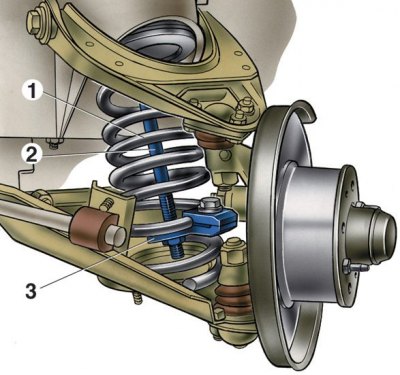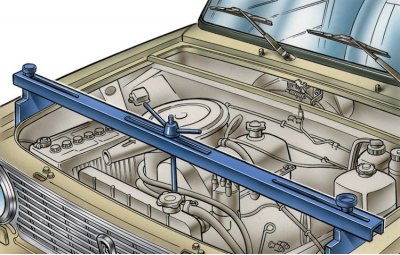2. Having straightened the locking plates, unscrew the bolts securing the caliper to the bracket. Take the caliper aside and secure it so that it does not hang on the hoses. Remove shock absorbers with brackets.
3. Disconnect the ends of the anti-roll bars from the lower control arms.
4. Puller 67.7801.9513 press the fingers out of the holes of the levers and move the steering rods to the side.

5. Insert screw 2, tools 67.7828.9504, into the hole of the upper support of the suspension spring, then from below put on the coil of spring 1 and screw 2 support plate 3 and fix it on the spring with a clamp. Screw the nut onto the screw from below so that the nut retainer enters the socket of the plate 3. By turning the screw 2 with a wrench, compress the suspension spring until the suspension arms are completely unloaded.
6. Take out an axis of the top lever and disconnect it from a body. Disconnect the lower arm axle from the cross member and remove the suspension assembly from the vehicle.
7. Remove the spring, gently unloading it, remove the fixture and repeat the operations for another suspension unit.
Attention! When removing the suspension units, it is necessary to note the number and location of the washers between the axis of the lower arm and the cross member, as well as the adjusting plates between the cross member and the side members of the body, so that when installing the units, put these washers and plates in their original place.
8. Remove the engine mudguard and stabilizer bar.

9. Supporting the engine with A.70526 traverse or hoist, remove the cross member.
10. Establish knots and details of a suspension bracket in an order, the return to removal. Install the springs on the front and rear suspensions of the same group (group A is marked with yellow paint, and group B springs with green). In exceptional cases, it is allowed to install group A springs on the front suspension, and group B springs on the rear suspension. If group B springs are installed on the front suspension, then install springs of the same group on the rear suspension.
11. To prevent incorrect distribution of forces in rubber-metal joints, tightening nuts and lever axles must be done in the following order:
- put the car on a level ground and put the wheels parallel to the axis of the car;
- load the car with a load of 320 kgf (four people 40 kg in the trunk);
- under these conditions, with a torque wrench, tighten the nuts securing the axles of the upper, and then the lower arms and the nuts securing the axle of the lower arm to the cross member.
12. Check and adjust the angles of the front wheels.
